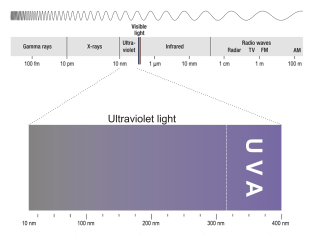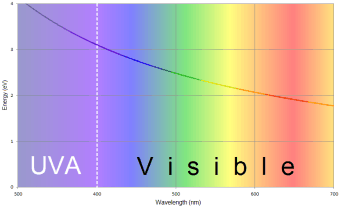DLPA060B July 2015 – November 2024 DLP7000UV , DLP9000XUV , DLP9500UV
1 Introduction
The UVA region of the ultraviolet spectrum covers wavelengths from 315 to 400 nm. UV DMDs are specifically designed to operate within the upper part of the UVA region. (See each specific DMD data sheet for the specific operational wavelength limits.) The relationship between wavelength and photon energy is given by Equation 1. Where:

- h is Planck’s constant
- c is the speed of light
- λ is the wavelength of the light
 Figure 1-1 UVA
region of the Ultraviolet Spectrum
Figure 1-1 UVA
region of the Ultraviolet Spectrum Figure 1-2 Photon
Energy in UVA and Visible Spectrum
Figure 1-2 Photon
Energy in UVA and Visible SpectrumSince both values in the numerator of Equation 1 are constants, this shows that photon energy is solely dependent on the reciprocal of wavelength. The smaller the wavelength, the higher the energy carried by each photon. Therefore, light in the UVA range, of which wavelengths are shorter than in the visible region, carries more energy in each photon than light in the visible spectrum.
In addition to more energy available in each photon, for photosensitive materials, shorter wavelengths of light also allow smaller features to be imaged since diffraction-limited spot size is directly proportional to the wavelength and ƒ-number. Examples of applications that benefit from smaller spot size and higher energy per photon are direct imaging lithography and various types of 3D printing. The former typically uses a photosensitive emulsion called a photoresist, and the latter uses photopolymer resins. These photoresist and resin materials are more reactive to the higher photon energy in the UVA spectrum which results in faster cure rates, and the smaller spot size results in sharper details.
Remarkable design techniques, as well as UV-optimized window anti-reflective (AR) coatings, are employed in UV DMDs that are specified to operate in the UVA spectrum, such as the DLP7000UV, DLP9500UV, and DLP9000XUV DMDs. These DMDs, along with the combination of common photoresists and resins optimized for wavelengths in this band, as well as readily-available Light Emitting Diodes (LED) and laser diodes in this spectral range, create an excellent combination of components to manufacture systems optimized for UVA.
A TI DLP DMD modulates light using reflective micromirrors that switch between two physical states. Since the primary modulation control of a DMD is reflection from inorganic aluminum micromirrors, these devices are significantly more tolerant of shorter wavelengths than spatial light modulator (SLM) technologies that use organic molecules for modulation control. Organic molecules tend to degrade when exposed to these shorter wavelengths of light.Ref 1,2
This application note explores the design considerations to maximize the performance of systems that use DMDs in the shorter wavelengths of UVA.